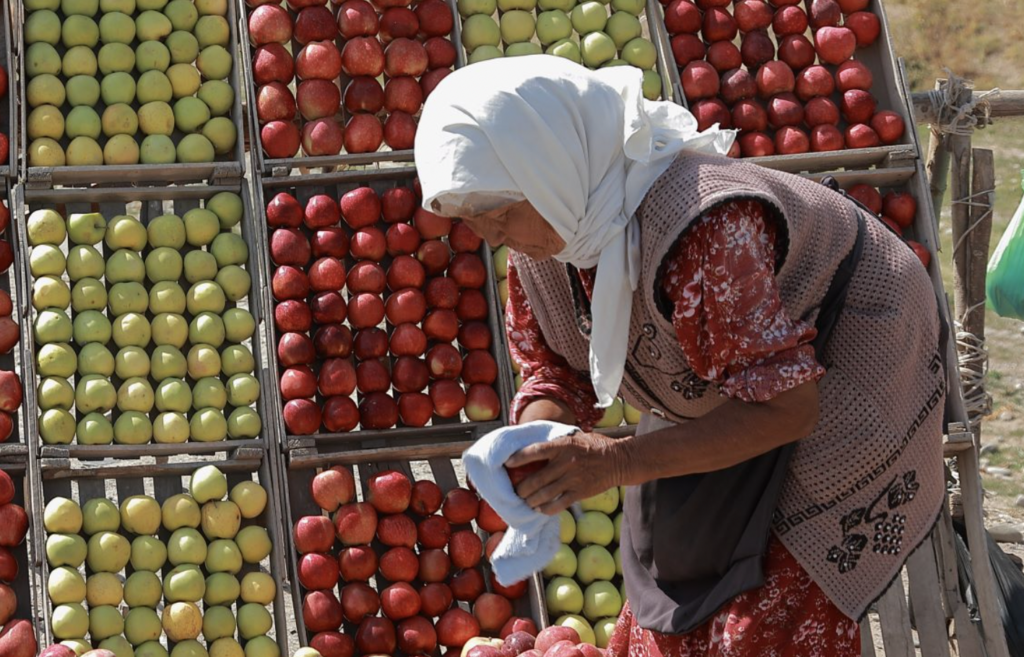122 million more people pushed into hunger since 2019 due to multiple crises, reveals UN report
Over 122 million more people are facing hunger in the world since 2019 due to the pandemic and repeated weather shocks and conflicts, including the war in Ukraine, according to the latest State of Food Security and Nutrition in the World (SOFI) report published today jointly by five United Nations specialized agencies.

If trends remain as they are, the Sustainable Development Goal of ending hunger by 2030 will not be reached, the Food and Agriculture Organization of the United Nations (FAO), the International Fund for Agricultural Development (IFAD), the United Nations Children’s Fund (UNICEF), the World Health Organization (WHO) and the World Food Programme (WFP) warn.
A wake-up call for the fight against hunger
The 2023 edition of the report reveals that between 691 and 783 million people faced hunger in 2022, with a mid-range of 735 million. This represents an increase of 122 million people compared to 2019, before the COVID-19 pandemic.
While global hunger numbers have stalled between 2021 and 2022, there are many places in the world facing deepening food crises. Progress in hunger reduction was observed in Asia and Latin America, but hunger was still on the rise in Western Asia, the Caribbean and throughout all subregions of Africa in 2022. Africa remains the worst-affected region with one in five people facing hunger on the continent, more than twice the global average.
“There are rays of hope, some regions are on track to achieve some 2030 nutrition targets. But overall, we need an intense and immediate global effort to rescue the Sustainable Development Goals. We must build resilience against the crises and shocks that drive food insecurity-from conflict to climate, said UN Secretary-General António Guterres through a video message during the launch of the report at the UN Headquarters in New York.
The heads of the five UN agencies, FAO Director-General QU Dongyu; IFAD President Alvaro Lario; UNICEF Executive Director Catherine Russell; WFP’s Executive Director Cindy McCain; and WHO Director-General Dr. Tedros Adhanom Ghebreyesus write in the report’s Foreword: “No doubt, achieving the Sustainable Development Goal target of Zero Hunger by 2030 poses a daunting challenge. Indeed, it is projected that almost 600 million people will still be facing hunger in 2030. The major drivers of food insecurity and malnutrition are our “new normal”, and we have no option but to redouble our efforts to transform agrifood systems and leverage them towards reaching the Sustainable Development Goal 2 (SDG 2) targets.”
Beyond hunger
The food security and nutrition situation remained grim in 2022. The report finds that approximately 29.6 percent of the global population, equivalent to 2.4 billion people, did not have constant access to food, as measured by the prevalence of moderate or severe food insecurity. Among them, around 900 million individuals faced severe food insecurity.
Meanwhile, the capacity of people to access healthy diets has deteriorated across the world: more than 3.1 billion people in the world – or 42 percent – were unable to afford a healthy diet in 2021. This represents an overall increase of 134 million people compared to 2019.
Millions of children under five continue to suffer from malnutrition: in 2022, 148 million children under five years of age (22.3 percent) were stunted, 45 million (6.8 percent) were wasted, and 37 million (5.6 percent) were overweight.
Progress has been seen in exclusive breastfeeding with 48 percent of infants under 6-months of age benefiting from this practice, close to the 2025 target. However, more concerted efforts will be required to meet the 2030 malnutrition targets.
New evidence: Urbanization is driving changes in agrifood systems
The report also looks at increased urbanization as a ‘megatrend’ affecting how and what people eat. With almost seven in ten people projected to live in cities by 2050, governments and others working to tackle hunger, food insecurity and malnutrition must seek to understand these urbanization trends and account for them in their policymaking.
In particular, the simple rural and urban divide concept is no longer sufficient to understand the ways in which urbanization is shaping agrifood systems. A more complex rural-urban continuum perspective is needed considering both the degree of connectivity that people have and types of connections that exist between urban and rural areas.
For the first time, this evolution is documented systematically across eleven countries. The report illustrates that food purchases are significant not only among urban households but also across the rural-urban continuum, including those residing far from urban centers. The new findings also show how consumption of highly processed foods is also increasing in peri-urban and rural areas of some countries.
Unfortunately, spatial inequalities remain. Food insecurity affects more people living in rural areas. Moderate or severe food insecurity affected 33 percent of adults living in rural areas and 26 pe in urban areas.
Children’s malnutrition also displays urban and rural specificities: the prevalence of child stunting is higher in rural areas (35.8 percent) than in urban areas (22.4 percent). Wasting is higher in rural areas (10.5 percent) than in urban areas (7.7 percent), while overweight is slightly more prevalent in urban areas (5.4 percent) compared to rural areas (3.5 percent).
The report recommends that to effectively promote food security and nutrition, policy interventions, actions and investments must be guided by a comprehensive understanding of the complex and changing relationship between the rural-urban continuum and agrifood systems.
What they said
FAO Director-General, QU Dongyu: “Recovery from the global pandemic has been uneven, and the war in Ukraine has affected the nutritious food and healthy diets. This is the ‘new normal’ where climate change, conflict, and economic instability are pushing those on the margins even further from safety. We cannot take a business-as-usual approach.”
IFAD President, Alvaro Lario: “A world without hunger is possible. What we are missing is the investments and political will to implement solutions at scale. We can eradicate hunger if we make it a global priority. Investments in small-scale farmers and in their adaptation to climate change, access to inputs and technologies, and access to finance to set up small agribusinesses can make a difference. Small-scale producers are part of the solution. Properly supported, they can produce more food, diversify production, and supply both urban and rural markets – feeding rural areas and cities nutritious and locally grown food.’’
UNICEF Executive Director, Catherine Russell: “Malnutrition is a major threat to children’s survival, growth and development. The scale of the nutrition crisis demands a stronger response focused on children, including prioritizing access to nutritious and affordable diets and essential nutrition services, protecting children and adolescents from nutrient-poor, ultra-processed foods, and strengthening food and nutrition supply chains including for fortified and therapeutic foods for children.”
WFP Executive Director, Cindy McCain: “Hunger is rising while the resources we urgently need to protect the most vulnerable are running dangerously low. As humanitarians, we are facing the greatest challenge we’ve ever seen. We need the global community to act swiftly, smartly, and compassionately to reverse course and turn the tide on hunger. At WFP, we are committed to working with all our partners – both old and new – to create a world where no one questions when their next meal will come.”
WHO Director-General, Dr. Tedros Adhanom Ghebreyesus: “Child wasting remains unacceptably high and there has been no progress in reducing child overweight. We need targeted public policies, investments and actions to create healthier food environments for all.”
Notes to the editor: the SOFI report
The State of Food Security and Nutrition in the World is an annual report jointly prepared by the Food and Agriculture Organization of the United Nations (FAO), the International Fund for Agricultural Development (IFAD), the United Nations Children’s Fund (UNICEF), the World Food Programme (WFP) and the World Health Organization (WHO).
Since 1999, it monitors and analyses the world’s progress towards ending hunger, achieving food security and improving nutrition. It also provides an in-depth analysis of key challenges for achieving these goals in the context of the 2030 Agenda for Sustainable Development. The report targets a wide audience, including policymakers, international organizations, academic institutions and the general public.
This year’s theme is aligned with the UN General Assembly “New Urban Agenda” and will complement and guide the discussions at the 2023 High Level Political Forum – particularly on sustainable cities and communities (SDG 11), and especially during the three-day ministerial segment of the forum held from 17 to 19 July 2023 and in the lead-up to the SDG Summit in September.
Glossary of key terms
Acute food insecurity: food insecurity found in a specified area at a specific point in time and of a severity that threatens lives or livelihoods, or both, regardless of the causes, context or duration. Has relevance in providing strategic guidance to actions that focus on short-term objectives to prevent, mitigate or decrease severe acute food insecurity. This indicator is used in the Global Report on Food Crisis (FSIN and Global Network Against Food Crises. 2023).
Hunger: an uncomfortable or painful sensation caused by insufficient energy from diet. In this report, the term hunger is synonymous with chronic undernourishment and is measured by the prevalence of undernourishment (PoU).
Malnutrition: an abnormal physiological condition caused by inadequate, unbalanced or excessive intake of macronutrients and/or micronutrients. Malnutrition includes undernutrition (child stunting and wasting, and vitamin and mineral deficiencies) as well as overweight and obesity.
Moderate food insecurity: a level of severity of food insecurity at which people face uncertainties about their ability to obtain food and have been forced to reduce, at times during the year, the quality and/or quantity of food they consume due to lack of money or other resources. It refers to a lack of consistent access to food, which diminishes dietary quality and disrupts normal eating patterns. It is measured with the Food Insecurity Experience Scale and contributes to track the progress towards SDG Target 2.1 (Indicator 2.1.2).
Severe food insecurity: a level of severity of food insecurity at which, at some time during the year, people have run out of food, experienced hunger and at the most extreme, gone without food for a day or more. It is measured with the Food Insecurity Experience Scale and contributes to track the progress towards SDG Target 2.1 (Indicator 2.1.2).
Undernourishment: a condition in which an individual’s habitual food consumption is insufficient to provide the amount of dietary energy required to maintain a normal, active, healthy life. The prevalence of undernourishment is used to measure hunger and progress towards SDG Target 2.1 (Indicator 2.1.1).
Related news
FAO food price index rose slightly in June due to higher prices of meat, dairy products and vegetable oils
The Food and Agriculture Organization of the United Nations (FAO)…
Read more >Fiatalok az agrár-élelmezési szektorban a FAO kutatása szerint
The Food and Agriculture Organization of the United Nations (FAO)…
Read more >This year’s FAO scholarship recipients graduated in biotechnology and water management engineering
This diverse community is not only proof of the global…
Read more >Related news
Corporate leaders’ commitment to sustainability at record level
According to the latest data from the K&H Sustainability Index,…
Read more >FAO food price index rose slightly in June due to higher prices of meat, dairy products and vegetable oils
The Food and Agriculture Organization of the United Nations (FAO)…
Read more >What can cause the price of a wine to increase tenfold?
There are fewer of them worldwide than the number of…
Read more >





